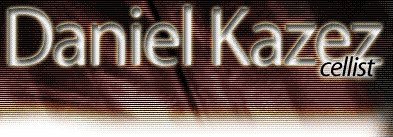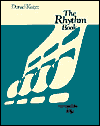
Rhythm Reading: Elementary Through Advanced Training
I’ve written two text books on rhythm. Both emphasize rhythm cells and the speech-cue method. My "big book" is Rhythm Reading: Elementary Through Advanced Training, 2nd ed. (W.W. Norton, 1997). It designed for music majors, and is widely used throughout the U.S., Canada, U.K., and Australia. Rhythm Reading is published by W.W. Norton. (Click to see the Rhythm Reading page on the W.W. Norton website.)The Rhythm Book
My other book is The Rhythm Book, 2nd edition (Accura Music, 1994). This book may be ordered directly through the publisher (Accura Music).

Reviews for The Rhythm Book
Clearly organized, succinct and to the point...The Rhythm Book is an exemplary work that will be useful to teachers of all instruments everywhere.
Scott McBride Smith, American Music Teacher (October/November 1996)The Rhythm Book is clear and concise, characteristics common to other publications of Mr. Kazez, both articles and books.... [T]he book is strong in its thoughtfulness and thoroughness in presenting a compendium of lessons which are helpful for students at the beginning stage of learning both theory and sound relationships that form the basis of rhythm in traditional western music.
Sheldon Atovsky, The Diapason (November 1996)Rhythm is often the weaker element where music-reading is concerned, and this book is a thorough study of how to increase one’s reading skills.... The Rhythm Book is excellent, and there is plenty of food for thought and exercises for practice.... I would heartily recommend this book for its carefully considered approach.
Alyson Lewin, Recorder Magazine (November 1996)Designed to help students learn to perform rhythm patterns...The Rhythm Book will be useful for [both] instrumental and vocal students.
Jane Magrath, Clavier (March 1996)If any of your students have trouble reading rhythm, The Rhythm Book will solve their problems...a terrific book...contains one of the best explanations of compound meters I have ever encountered....
Mark Morton, International Society of Bassists (Winter 1996)The Rhythm Book...focuses on the rhythm encountered in band, orchestral, choral, solo and chamber music.... [T]he material will improve players of any persuasion.
Mark Gilbert, Jazz Journal International (1996)The Rhythm Book is "very useful indeed, well ordered and presented.... Kazez gradually unfolds his material in a logical fashion, allowing the student to assimilate rhythmic cells slowly and then re-use them in subsequent exercises.
Chris Kilvington, Classical Guitar (November 1995)From the Preface of The Rhythm Book
The Rhythm Book is designed to help students learn to perform the rhythm patterns they will encounter in band, orchestral, choral, solo, and chamber music. It may be used in class or private instruction. The Rhythm Book encourages students to read rhythm not as individual notes but as groups of notes. Each group of notes is known as a rhythm "cell" or "chunk." Each exercise serves to teach a new cell and review cells already learned. Once introduced, each rhythm cell recurs at regular intervals throughout the rest of the book. In other words, spiral learning is used.New rhythms are often taught not on a fixed syllable (such as "Ta"), but on a carefully selected word. This is called the "speech cue method." The speech cue makes it easier for students to learn and remember the rhythm cells. For example, the rhythm sixteenth-sixteenth-eighth is taught with the word "telephone."
Each exercise is designed to be sung or played on an instrument. For vocalists and players of wind instruments, phrases are short enough to permit proper breathing. For string players, bowings are added when necessary.
Daniel Kazez
Professor Emeritus of Music
Wittenberg University
Springfield, Ohio USA